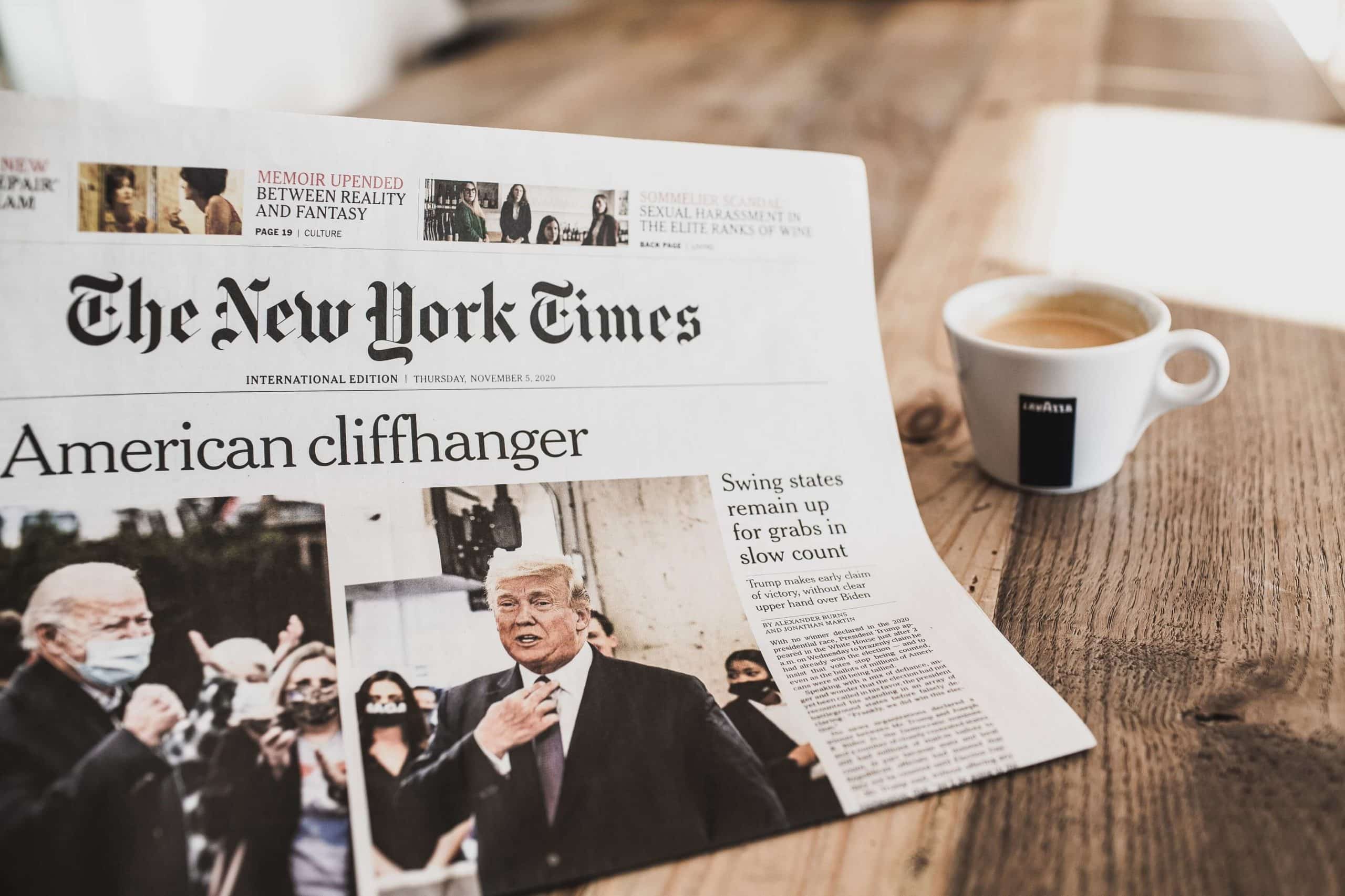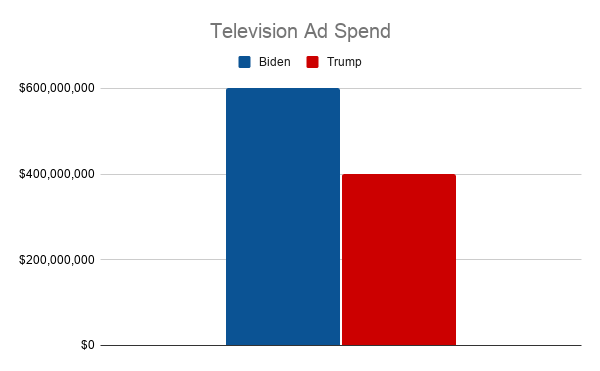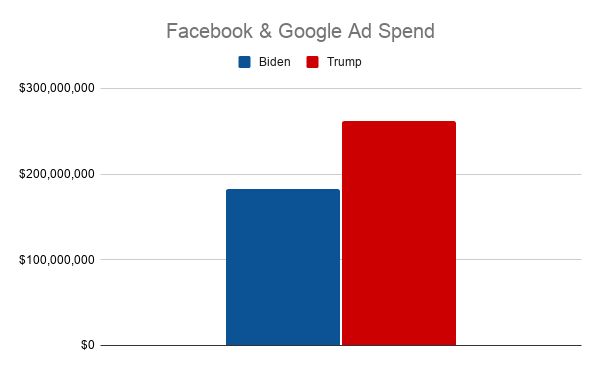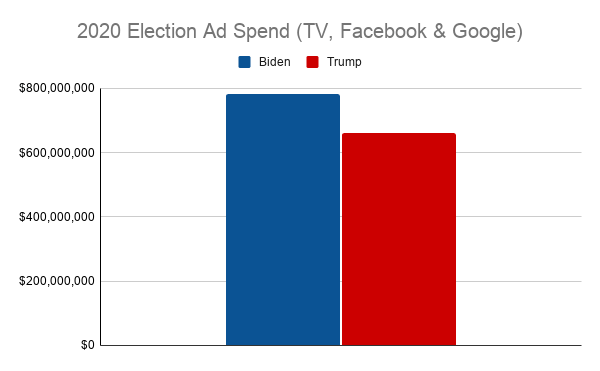The 2020 US election was a nailbiter. We’re here to share facts and our insights on the election campaign advertising strategies.
Disclaimer: This blog is meant to share facts and insights; in no way is it a reflection of favour towards Trump or Biden. We are discussing the election campaigns on a general level regarding digital advertising.
Up to November 3rd, 2020 (and the next few days after that), the world has been refreshing the Associated Press’s dashboard on Google search every five minutes, biting their nails, trying to see what the results for the US election results were.
For both parties, the ad spend on traditional media advertising proportionally outweighs what they’ve spent on digital ads. In this article, we will share some insights, our opinions on how digital should have been leveraged, and predictions for the future US election advertising trends!
Here are the topics we’ll cover:
Photo by Jonathan Simcoe on Unsplash
Breakdown of US Election
Money Raised & Spent
The Center For Responsive Politics (CPR) shares that the 2020 US election is the most expensive in America’s history, breaking records! About $14 billion was spent – which is twice as expensive as the 2016 elections!
Take a look at the comparison to previous elections in the graph below:
These funds came from campaigning and donations from different groups.
Compared to 2016, the amount of Large Individual Donations have decreased, whereas we see increases in Small Individual Donations and self-funding from wealthy individuals.
Small individual donations are $200 or less, grown from 15% to 22%. A big reason for this is because of COVID-19. Extravagant, in-person fundraising events have been written off for 2020. Campaigns quickly adapted to a pandemic, where they fundraise through emails, text messages, and other virtual means. We believe that this made donating more accessible to the general public. Especially if you consider statistics like text and emails being millennials’ preferred method of communication. 83% of Millennials open text messages within 90 seconds of receiving a text message!
Here are some numbers of investment each party has put into the US election advertising campaigns:
Note that the numbers presented above are merely from television, Google, and Facebook advertising. Not including other social platforms or print, so the total ads spend of both parties would be even higher!
Biden’s campaign spent significantly more than Trump in television ads but still had the election results come in so close. Call us biased (towards online ads), but we think the digital ads penetrated the audience market more. Both parties should have allocated more budget to online instead of paying big bucks on traditional advertising like television, radio, and newspapers.
Digiday’s recent article also supports this point. They cited digital analysts and media buyers successfully predicted that 20% of the ad budget would be dedicated to digital ads. However, now the results are out, some candidates who lost their seats in the House and Senate wonder if a fifth of the budget was enough.
Unlike business brands that have been savvy with social media and paid ad campaigns for several years, political parties are still catching up with the current digital advertising trends. One of the experts, Katelyn Raman, who was interviewed in the article hit the nail on the head. She said that political campaigners might have the misconception that posting consistently on social media automatically means people will see it. Instead:
We couldn’t agree more. People consume news and media through different channels and communicators, so a multi-pronged approach is a must!
Photo by Clay Banks on Unsplash
US Election:
Online Advertising Platforms
Facebook Ads
Facebook (including Instagram) offers granular audience targeting.
Political parties usually leverage Facebook due to the functionality of uploading mass email lists and creating lookalike audiences.
In 2020, Facebook had faced criticism and even boycotts over their stance on censorship. Facebook CEO Zuckerberg cites the reason for his refusal to put fact-checking measures in place is that he doesn’t want to interfere with free speech.
Due to the criticism from the public, Facebook has since then made some alterations when it comes to political ads:
- Political ad spending now public through Facebook’s ad library to increase transparency.
- Ban ads that delegitimize the outcome of an election (for example, prohibiting ads that call voting by mail fraudulent).
- Facebook will stop running political ads in the United States when polls close on November 3rd, 2020, for an indefinite period.
Earlier we mentioned that Trump spent more on Facebook Ads than Biden. Take a look at a detailed breakdown of Facebook Ads of the two from a marketing expert. He breaks down ads, messaging, landing pages etc. We found this video insightful especially for those outside of the US who don’t get to see the actual ads that have been run.
US political ads will make up 3% of Facebook’s advertising revenue for the third quarter in 2020.
Facebook ads are going nowhere. We expect it to still be one of the biggest players in political elections in the future as its audience targeting capabilities are unparalleled. We predict that most online marketing campaigns on Facebook will have the objectives set to brand awareness and lead generation (signing up for campaign newsletter). Young audiences, those in swing states, and retargeted audiences will also be segments campaigns should allocate budgets to.
No doubt there will be some finetuning and updated regulations on Facebook’s end, but we advertising folk are quick to adapt.
Google has been an integral part of the election process. They implemented support for the elections on Google Search, Youtube, and Google Assistant (mobile and smart home device). They provided the general public with information on accurate directions to polls, ballot drop locations on Maps, give the most up-to-date election results, access real-time news and more.
Just like Facebook, Google also decided to ban political ads after election day.
Google’s requirements for political ad content are strict. You must comply with local legal requirements, and non-compliance with their policies may result in the advertisers’ ad campaigns and accounts being disclosed publicly to government agencies and regulators. Google tries to be highly transparent and has restrictions on how political parties target audiences. Only these criteria are allowed:
- Age
- Gender
- Geographic location (radius targeting is not permitted)
- Contextual options: keywords, ad placements, etc
The usual audience targeting options such as remarketing, geographic radius targeting, and uploaded email lists are prohibited.
Photo by Markus Spiske on Unsplash
Our Advertising Recommendations For Future US Elections
Creative Measures to Reach New Audiences
Overlooked audiences include those that are first-time voters or those with no record of voting. It’s hard for political campaigns to target this demographic as they are probably not on the campaign subscription list. To permeate one’s campaign and message to this crowd, one must be creative. Since Twitter, TikTok has completely banned political ads, but that doesn’t mean their audience base of millions of active users will waste. Political parties should collaborate with like-minded influencers and spread their message organically through video and visual posts.
Content like memes can create rapport through humor amongst the younger generation to warm them up to being politically-involved!
Multi-Language Ads For Multicultural Demographics
Both Trump and Biden had Spanish ads running on television, radio and online with their messaging tweaked for different states. It’s crucial to consider America’s melting pot of multiculturalism. Latinx, Asian-Americans, Native-Americans, and other groups should all have dedicated campaigns, some even in their native language if political campaigns genuinely want to connect with different demographics.
For multicultural campaigns, they might be limited in traditional advertising like television and radio ads. There might be a specific timeslot for a Spanish show for the ad to play. But what if the target audience is at work or doesn’t have access to a tv or car radio at the specific time the ad is being run?
This brings us to our next point: in the next election, political parties should invest more in digital advertising, which offers many channels for ad placement to reach specific audiences.
Invest More in Digital Advertising
In the 2020 US election, both the Democratic and Republican parties invested around a fifth of their advertising budget to online ads. We think they would get the most bang for their buck if they took more of their budget from traditional ads and put it towards digital. Digital advertising is cost-effective, flexible, and can be served anytime, anywhere. We specifically think Display, Video, Audio, and Digital-Out-Of-Home Ads would work well for political campaigns in the future.
Desktop & Mobile
People are spending much more time on their computers, laptops, and mobile phones at home and in public (on transit, at cafes, etc.). Display ads can be useful for capturing them as they browse on their devices. Specific targeted ads can be served to them anytime, anywhere.
Youtube is the second largest search engine after Google. People watch 1 billion hours of Youtube videos a day—video content is being consumed significantly, so it would be a good idea to invest in video advertising for maximum exposure. People are visual creatures, so video format is an engaging way to catch a viewer’s attention.
TV Alternatives
Streaming media content through TVs has become increasingly common; Roku, Amazon Firestick, Chromecast etc. have become popular. These are called Over-The-Top (OTT) advertising. These are ads delivered directly to viewers online through smart TVs or video streaming services, which captures audiences who may not be subscribed to cable TV.
On-The-Go: Visual & Audio
How do you capture audiences on the go? We want to bring your focus to two specific senses: visual and audio.
Digital-Out-Of-Home is the overarching term for ads on public digital billboards or signs. These often include large billboards in commercial districts, airport and train stations, sports arenas, malls…where there is high foot traffic. Thousands could see ads at any given time as they carry on their day outside.
Commuters and joggers are just two types of people that have their earphones plugged in. They might be streaming music or podcasts. Audio streaming platforms like Spotify have in-stream advertising that works like radio but can be streamed anytime, on the go. In 2020, Americans listen to 6 hours and 39 minutes of podcast per week. We also think the audio ad space is only going to grow.
Our Conclusion:
Programmatic is the Future
According to AdExchanger, by the end of 2020, advertisers will make 70% of d purchases programmatically. The robust access to ad space and personal data is unparalleled. As advertisers, we are responsible for shaping how people receive information and positively influence how they form opinions. We hope for transparency, accountability, and limitless potential in the ad tech industry for the years to come!
Our conclusion? For future US elections, political parties shouldn’t underestimate online advertising’s potential and consider moving some of their traditional advertising budgets to online to better reach their audiences in America.
What Have We Learned?
- 2020 US Elections broke the record of most money raised and spent for both the Democratic and Republican parties.
- The increase in small individual donations ($200 or less) is mainly due to COVID-19, where campaign fundraisers are online and virtual and instead of in-person.
- Biden spent 90+ million, and Trump spent 40+ million on television ads. Both spent under 35 million on online advertising, which is about a fifth of their campaign ad budget.
- Facebook and Google Ads are predominantly what each party invested in online. Other popular social platforms such as Twitter and TikTok have outright banned political advertising.
- Political parties are not as savvy when it comes to digital ad trends. They need a strong paid strategy to go with their robust content strategy online. A multi-pronged approach is how they can capture the desired audience.
- To target different demographics, political parties should spend more time on creating multi-language campaigns.
- Political parties should take the money from traditional advertising and allocate it to online ads in future elections because it offers more flexibility, audience-targeting, and cost-effective.
- We think these channels would be suitable investments: Display, Audio, Video, Over-The-Top, and Digital-Out-Of-Home ads.
- In 2020, 70% of online ads are purchased programmatically. The ad tech space is going to improve on functionality, accountability, and transparency continuously.






